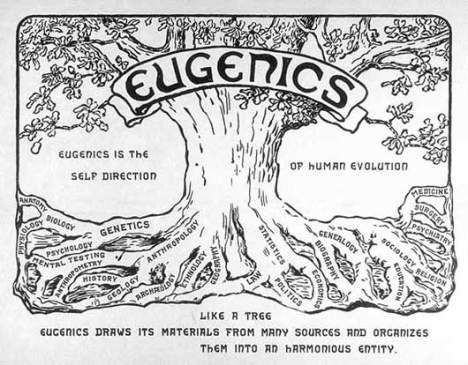Eugenics is a form of selective breeding by which society, not nature, determines who is fit to reproduce. Following the promulgation of Darwin’s theories of evolution, eugenic principles became widely popular. As a result, many countries adopted eugenic policies meant to improve the genetic “stock” of their countries.

As one scholar explained:
Applied eugenics deals with a conscious effort for improving the human race by such methods, as immigration regulation, birth control, restrictive marriage legislation, and human sterilization legislation.” (J. H. Landman, The Human Sterilization Movement, 24 Am. Inst. Crim. L. & Criminology 400, 1933-1934)
Dr. David Pfeiffer reported that in 1907, Indiana enacted the first involuntary sterilization law in the country. By 1911 four more states had enacted involuntary sterilization laws. By 1930 a total of thirty three states had enacted such laws although in three states – New Jersey in 1913, New York in 1918, and Indiana in 1921 – the laws were struck down as unconstitutional. In Michigan a law was enacted, but struck down in 1918.
In 1919, Idaho passed the state’s first compulsory sterilization bill targeting the “feeble-minded, insane, epileptic, moral degenerates and sexual perverts” who were inmates of public institutions. [Note that “sexual perverts” included homosexuals.] The governor vetoed the bill, even while lauding the bill as “meritorious,” on the grounds that it did not apply to all such persons, but only those already confined in public institutions “the persons in fact who by reason of such confinement are the least menace to society.”

The Northern Idaho Sanitarium built in 1905 at Orofino, Idaho with a capacity of 250 beds.
Thus, on this day in history, the Idaho Legislature passed another act “. . . to create a state board of eugenics; to provide for the sterilization of all feebleminded, insane, epileptics, habitual criminals, moral degenerates and sexual perverts who are a menace to society, and providing the means for ascertaining who are such persons.”
This new legislation was specifically constructed to avoid challenges made on the basis of unequal application. It created a Eugenics Board which was composed of the superintendents of the state institutions in charge of the care and housing of people with mental disorders with the responsibility of making decisions about whether residents of the state institutions should be sterilized. Such decisions were to be based on whether the residents were at risk of either reproducing children with certain undesirable traits (e.g., epilepsy, insanity, feeblemindedness), whether they were a menace to society, or whether they might become or were a burden to the state (Gen. Laws of the State of Idaho, ch. 194, No. 203, 359).
Although this legislation required consent from either the patient or their legal guardian, if consent was not given, then sterilization could still go occur provided that the board’s decision was affirmed by the district court. Tellingly, the legislation also stipulated that neither the board nor the physicians performing the sterilizations could be held legally responsible for their participation in operations.
According to Elyce Zenoff Ferster (“Eliminating the Unfit–Is Sterilization the Answer?,” Ohio State Law Journal: Volume 27, Issue 4, 1966), over 63,000 persons were involuntarily sterilized in the United States for genetically related reasons from 1921 to 1964.
In total, there were 38 victims in Idaho. Of the 38, eight were male and 30 were female. About 32% were deemed mentally ill and about 66% “mentally deficient,” with 1 of the 38 victims classified as “other.”
In 1931 the Idaho Supreme Court upheld the 1929 law in State v. Troutman (50 Idaho 673) citing the Supreme Court case of Buck v. Bell, 274 U.S. 200 (1927), asserting that “if there by any natural right for natively mental defectives to begat children, that right must give way to the police power of the state in protecting the common welfare, so far as it can be protected, against this hereditary type of feeble mindedness.”

Photograph of Supreme Court Justice Oliver Wendell Holmes. Courtesy of the Library of Congress.
The Idaho law on compulsory sterilization was repealed in 1972.
Coercive and involuntary sterilization has now been recognized as a crime against humanity and condemned by a variety of international organizations.
Filed under: History, legal, SCOTUS | Tagged: History, Idaho, legal |




Leave a comment